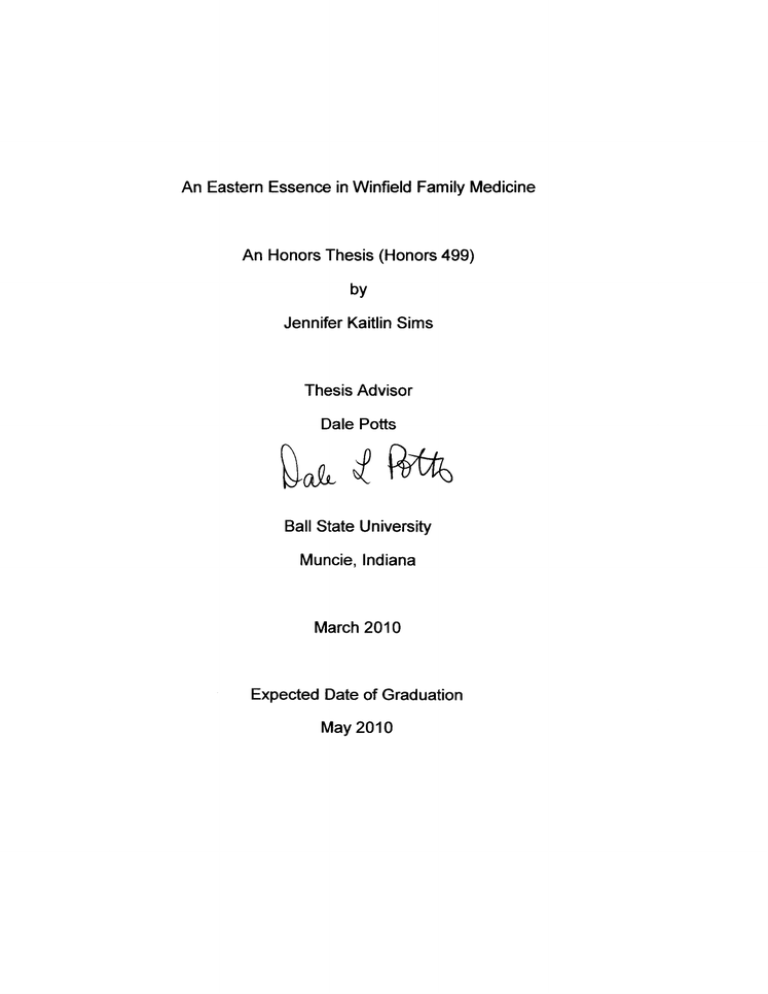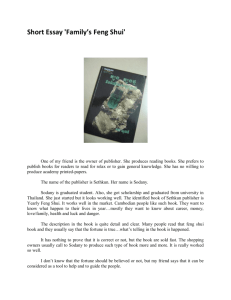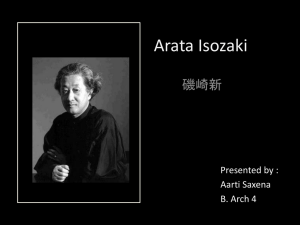An Eastern Essence in Winfield Family Medicine by Jennifer Kaitlin Sims
advertisement

An Eastern Essence in Winfield Family Medicine An Honors Thesis (Honors 499) by Jennifer Kaitlin Sims Thesis Advisor Dale Potts Ball State University Muncie, Indiana March 2010 Expected Date of Graduation May 2010 Abstract The space I chose to redesign is Winfield Family Medical in Crown Point, Indiana. focused on the family practice clinic located on the second floor, which is about 10,000 sq. ft. While part of the second floor is still unfinished, family practice and chiropractic offices occupy the rest of the space and are divided up into offices, exam rooms, break rooms, reception areas, and waiting rooms. The building is relatively new; it was built about a year ago. The owners have given me full permission to visit, photograph, and interview users of the space. Dr. Brent Jacobus and Dr. Brett Brechner are the two practicing doctors. The nurse practitioner, Dorothea Doolin, also works with the doctors at the clinic. Other staff members include receptionists and nurses. The overall design goal was to create a functional, visually attractive healthcare space by addressing users' needs and issues involving circulation, privacy, comfort, legibility, image, convenience, safety, durability, mood/ambience, and flexibility. The interconnected spatial relationships in the clinic suggest a state of balance and harmony. Eastern philosophical concepts of wellness derived from the areas of Taoism and Buddhism have been incorporated into the design and create areas of focus. Acknowledgements I would like to thank my family for their endless support and encouragement. I learned the value of hard work and perseverance from their examples. I dedicate my achievements to my family. Also, I would like to thank all of the professors in the interior design department at Ball State. Their wisdom, patience, and passion for their profession have made it easy to be a successful student in the program. lowe a special thank you to Mr. Dale Potts. Not only has he been an excellent advisor during the completion of this project, but he has been a personal mentor and role model during my four years in the interior design program. Author's Statement Winfield Family Medicine is the interior space I chose to redesign for my senior capstone project in the interior design program. After speaking with my advisor, I decided to develop the assigned senior project into an honors thesis creative project. We agreed that in addition to the required components of the project, I would create two additional boards that would exhibit my inspirational research for the design of the space. The result was "An Eastern Essence in Winfield Family Medicine." I explored Eastern philosophical concepts such as Taoism, Buddhism, and feng shui in relation to Eastern beliefs about well ness in order to apply these models in the design proposal for Winfield Family Medicine. The central organizing principle of Taoism is the interconnectedness of all life with its flows of continuous change. Yin-Yang describes the underlying unity of life through the interplay of opposites. Yin is the feminine, passive energy force and Yang is the masculine, active force of energy. Although the forces are strongly opposed, they are also strongly connected. Both energies are essential for life. Taoists write that all things and all processes contain two forces that are interdependent, complementary polar opposites. They are perceived in their relatedness, how one grows out of the other. Nature's tendency is to constantly move to a state of harmony and balance. The idea of change leading to harmonious balance underlines another aspect of Yin and Yang. Processes are constantly changing, forming cyclical patterns. They expand and contract; they are the breathing pattern of life. The essential message of Taoism is that life constitutes an organic, interconnected whole which undergoes constant transformation. Gaining an awareness of life's essential unity and learning to cooperate with its natural flow and order enables people to attain a state of being that is both free and independent, but at the same time fully connected to the flow of the universe. Feng shui is a product of Chinese philosophy and religion. The tie between humans and the universe evolved from the concept of Tao. Feng shui combined deep Taoist philosophy with a combination of folk cures, mysticism, early science, and Buddhism. The union resulted in a practical and intuitive approach to the environment that offers an array of useful, sensible, and mystical cures. Feng shui is based on the belief that everything that exists in the environment has movement and energy. The energy that each object emits is known as 'chi,' which translates as 'breath.' Chi is the life force that connects the mind to the heart, body, and mind to the surrounding world. The energy force is composed of two parts - the five elements which are fire, wood, water, earth, and metal and yin and yang. Practitioners of feng shui strive to live with nature, to clear their environment of negative chi, and to facilitate the flow of positive chi allowing it to flow freely throughout their homes and workspaces. Our conventional Western outlook is based on the assumption that humans are all separate entities, existing apart from each other and from the surrounding environment. Eastern philosophy, on the other hand, implies a trust and belief in one's own inner nature and in the interconnectedness of all life. In addition to research regarding the Eastern philosophical concepts, I studied three influential Japanese architects and their design work. The precedents are Kisho Kurokawa, Arata Isozaki, and Fumihiko Maki. Kisho Kurokawa was born on April 8, 1934 in Nagoya. He is known for his buildings, town-planning, product design, and for founding the Metabolism Movement in the 1960s. The Metabolism Group of architects produced large scale, flexible, extensible structures that enable an organic growth process. They believed that the laws of space and functional transformation held the future of society. Also, these architects attempted to think of architecture in terms of the Buddhist idea of transmigration. They utilized the metabolism of organic creatures as their model for change. Metabolist architects hoped that the use of biological processes would give them efficient ways to deal with the rapid growth and technological progress of societies all over the world. The phenomenon of metamorphosis exemplifies the process of growth and change in a dynamic balance. Another key principle in Kurokawa's work evolved from the concept of symbiosis, which is a term borrowed from biology used to describe the existence of heterogeneity in a flexible open order. His architecture symbiotically links traditional Asian ideas to innovative Western approaches. In his architecture, he seeks to mediate opposites. In contrast to Western conviction, the dominant Eastern conviction is that technology does not stand in conflict with humanity, but that technology is an expansion of humanity. Spaces and structures that are formed taking metabolistic cycles into consideration make it possible to replace parts that have lost usefulness; therefore, resources are conserved. His work demonstrates an abandonment of the 'machine principle' of modernism towards an organic 'principle of life.' Arata Isozaki agreed with the Metabolist Group on several points except one: the direct analogy between organic metabolism and architectural composition. He believed that change is dramatic and destructive, lying outside human control, and that it was meaningless to foresee the future alterations of a building as the Metabolists did. He referred to the Buddhist priest and scholar Vasubanhu, who clearly defines time as a single moment. In his architectural method, he combines the dynamism of the Judaic idea of termination and the Buddhist concept of time as reduced to the instant. His doctrine is similar to the Buddhist belief in the impermanence of all things. Isozaki felt that there was no other way to proceed in design than to trace every concept and form back to its origins. An important work completed by Isozaki is the Museum of Contemporary Art in Los Angeles. From the beginning of the design process, Isozaki recognized Los Angeles as a point of confluence between the cultures of the East and the West. He decided to provide a symbolic interpretation of both cultures, using his design to represent the Golden Section, the western method of establishing divisions, and the Yin-Yang philosophy as the corresponding Eastern method. The composition creates a vortex, stimulating flow while realizing both Eastern and Western spatial divisions. Isozaki successfully dismantled two seemingly segregated architectural styles in order to form a harmonious whole. While the united fragments lost their points of origin, a metaphor was created. Fumihiko Maki's architecture represents his belief in the pattern of metabolic change and in the evolving nature of individual and collective relationships. He creates environments defined by ecological and social equilibriums that offer satisfying contexts for existence. From his very first project, Maki has seen the role of the designer as 'charged with giving form - with perceiving and contributing order.' Maki's order is derived from his understanding of the relationship of parts to the whole. Maki said, "For each part to be meaningful in relation to the whole, for the whole to regulate its component's parts, and for tension to exist between the two can be called ideal conditions for architecture." When designing a building, Maki's first priorities were focused on the experiences people had in each of his spaces, while the aesthetic characteristics of the architectural structure were second in importance. Maki's buildings have a sense of resolution arising from an overall geometric order. Although Modernism and traditional Japanese architecture created Fumihiko Maki, he continually criticized Modernism, looking for its true form, which he believed involved flexibility with respect to function, humility towards the user, and continuity with the surrounding environment. After completing the required research for the project, I completed an "essence" board. The board includes information about Eastern philosophy and about the three precedent studies. Pictures of the architects' works are also included on this board. I referred to the essence board throughout the project to ensure that the design of Winfield Family Medicine emulated the inspirations. The other additional board that I completed for the honors thesis was the "floor plan essence" board. On this board, I used notations and justifications to explain how I implemented concepts from Eastern philosophy into the design. The colored regions on the floor plan highlight the areas of the clinic that encapsulate the essence of eastern philosophy. Overall, the clinic was designed to symbolically represent the essential message of Taoism which explains that life constitutes an organic, interconnected whole which undergoes constant transformation. The geometric, linear forms are balanced by organic designs. The circular shapes used in the design of the clinic are all connected to each other and grow out of one another. The cyclical relationships represent the expanding and contracting, breathing pattern of life. The other boards included in the completed project display the floor plan, ceiling plan, finish plan, elevations, 3D perspectives, and furniture/finishes. All eight boards are included on the provided CD-ROM. Also, the program has been included in the final work that summarizes the research I completed before redesigning Winfield Family Medicine regarding client information, needs, issues, goals, and initial space planning. Special attention was given to universal and sustainability guidelines. Works Cited Beale, C. (2006). Behind the healthcare boom. Retrieved October 12, 2009, from KI Healthcare Web site: http://www.kihealthcare.comlissues.aspx?ar=249&at=1 Drew, P. (1982). The architecture of Arata Isozaki. New York: Harper & Row Publishers. Duffy, T. (1997). Furniture. Healthcare Design (pp. 122-138). New York, NY: John Wiley & Sons, Inc. Feng Shui Elements. (2009). Retrieved October 27,2009, from LovetoKnow Web site: http://feng-shui.lovetoknow.com/Harmony_Concepts Flagge, I., Schmal, P. C., & Visscher,J. (2005). Kisho Kurokawa: Metabolism and symbiosis. Berlin: jovis Verlag. Fuston, A., & Plaskon, K. (1997). Creating nontoxic, health-enhancing environments. Healthcare design (pp. 232-254). New York, NY: John Wiley & Sons, Inc. Hamilton, D. K. (2003). The four levels of evidence-based design. Healthcare Design, 3(4), 18-26. Isozaki, A. (1998). Arata Isozaki: Four decades of architecture. New York: Universe Publishing. Kardash, T. (2009). Taoism - Ageless wisdom for a modem world. Retrieved October 27,2009, from Jade Dragon Online Web site: http://jadedragon.com/tao_heal/ taopart3.html Knoll Inc. (2008). Evidence-based design recommendations for nursing stations. Retrieved October 12, 2009, from Knoll: White Papers and Topic Briefs Web site: http://www.knoll.com/products/ hc_research.jsp Litch, K. B. (2007). The marriage of form and function: Creating a healing environment. Healthcare Executive, 22(4):20-2, 24, 26-7. Malkan, S. (2007). The architecture of healing. Retrieved October 12, 2009 from Health Leaders Media Web site: http://www.healthleadersmedia.com/contentl90248/ topicIWS_HLM2_HOMffhe-Architecture-of-Healing.html Miller, R, & Swensson, E. (1995). New markets, new design principles. New directions in hospital and healthcare facility design (pp. 33-60). New York, NY: McGraw-Hili, Inc. Miller, R, & Swensson, E. (1995). Principles: New paradigms for a new century. New directions in hospital and healthcare facility design (pp. 1-18). New York, NY: McGraw-Hili, Inc. Miller, R, & Swensson, E. (1995). Women's health facilities and pediatrics. New directions in hospital and healthcare facility design (pp. 257-264). New York, NY: McGraw-Hili, Inc. Rossbach, S., & Yun, L. (1998). Feng shui design. New York: Penguin Group. Ruga, W. (1997). Designing for the senses. Healthcare design (pp. 217-231). NeNYork, NY: John Wt'ey & Sons, Inc. Taylor, J. (2003). The architecture of Fumihiko Maki: Space, city, order, and making. Basel; Boston: Birkhauser - Publishers for Architecture. u.s. Department or Justice. (1994). 28 CFR Part 36: ADA standards for accessible design. Retrieved October 12, 2009, from ADA Home Page Web Site: http://www.ada.gov.







